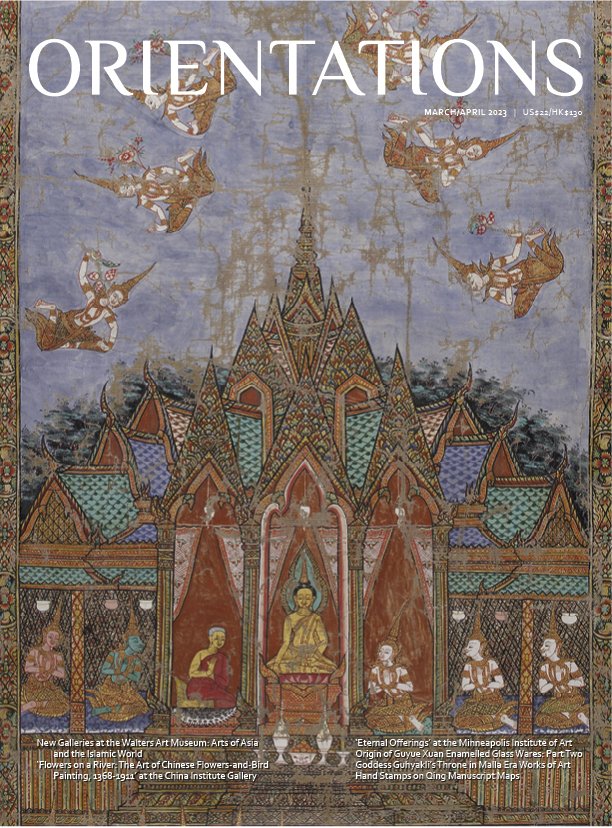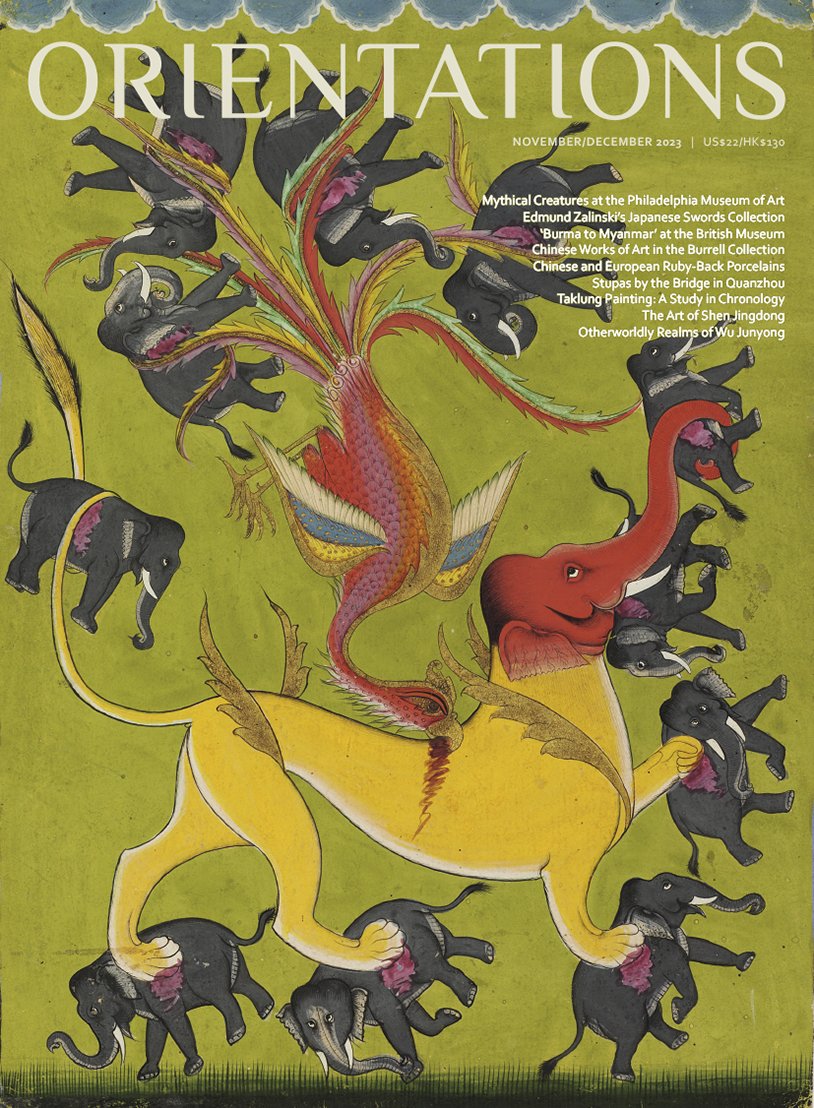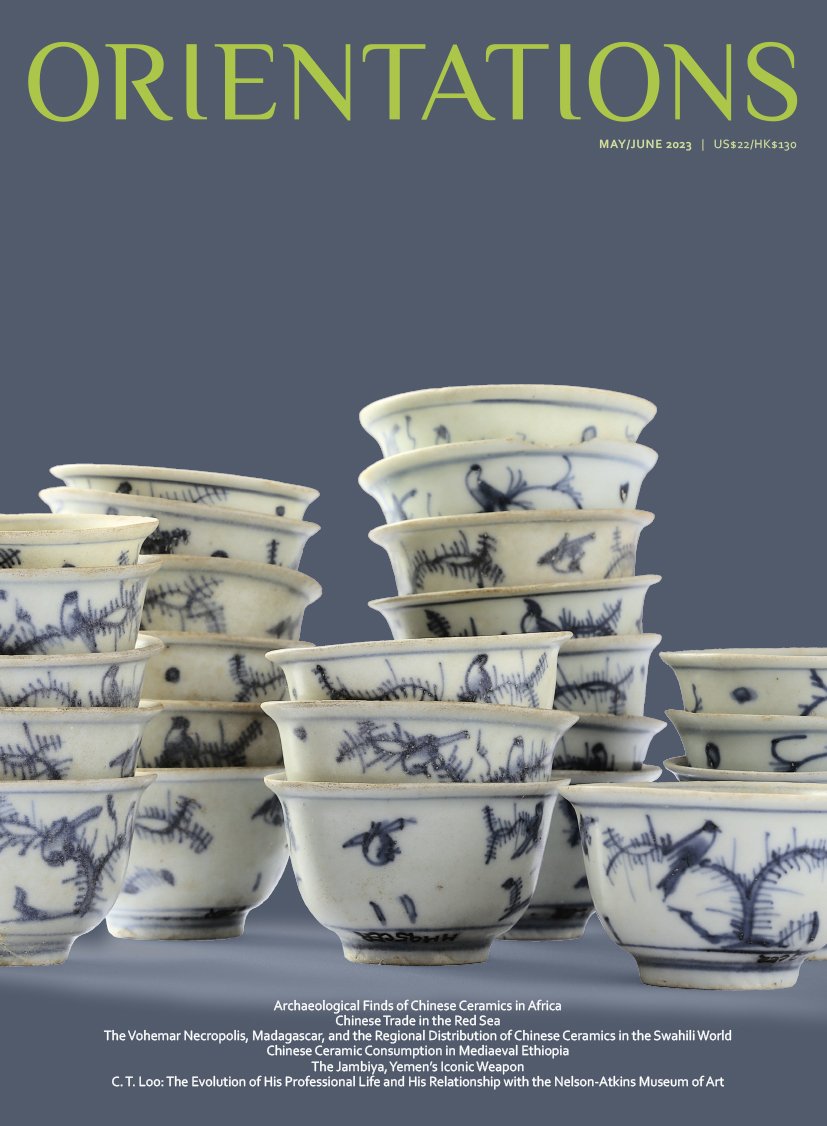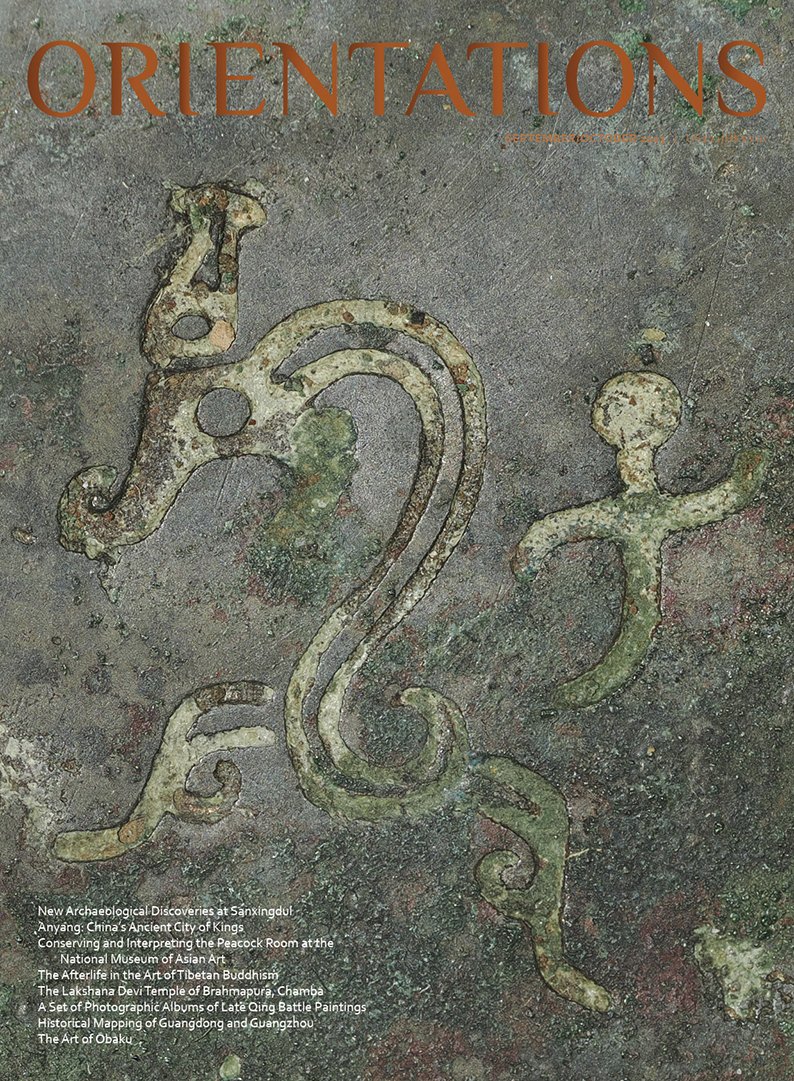 Image 1 of
Image 1 of


MAR/APR 2023
VOLUME 54 - NUMBER 2
The Walters Art Museum was founded in 1934 in Maryland in the United States when Henry Walters (1848–1931) do-nated two buildings, an endowment to the City of Baltimore, and a collection started by his father, William T. Walters (1820–94), a businessman with interests in several industries. The founding collection of 22,000 objects across cultures reflected the tastes of the father and son, shaped by Western beliefs prevalent during the 19th and 20th centuries. It has now grown through purchases and further donations to more than 36,000 objects. The museum fulfils its mandate of ‘for the benefit of the public’ with free public admission year-round.
This issue focuses on the new installation ‘Across Asia: Arts of Asia and the Islamic World’ with nearly 600 works of art, many of which are either on display for the first time in almost a decade or for the first time ever. It strives to provide a cross-cultural view of the arts from this geographical expanse. One of the highlights is a 19th century wooden thammat, or a raised platform or pulpit used by seated monks, with lacquer, gold, and coloured cut and inlaid glass, a gift from the Duke Charitable Trust in 2002 but which was kept in storage until now. Despite being Thai in origin, its decorations connect it to Indian, Khmer, Mon Hindu-Buddhist, and Chinese architectural motifs. We also show the global popularity of tea and the transmission and localization of tea wares from East Asia to beyond.
Following in the footsteps of its 2018 exhibition ‘Power and Beauty from China’s Last Dynasty’, produced in collabora-tion with experimental stage director Robert Wilson, the Minneapolis Institute of Art has teamed up again to open ‘Eternal Offerings: Chinese Ritual Bronzes’, this time with Oscar-winning art director and film designer Tim Yip. Some of Yip’s best-known works include Ang Lee’s film Crouching Tiger, Hidden Dragon and John Woo’s Red Cliff. The exhibition will showcase the museum’s archaic Chinese bronzes collection, one of the best in the United States, the core of which was bequeathed to the museum in 1950 by Alfred Fiske Pillsbury (1869–1950), whose dealer was C. T. Loo (1880–1957). Yip’s dramatic design emphasizes the power of the senses and as such seeks to transport visitors into the environment for which these works of art were produced. The absence of didactic materials is meant to encourage viewers to experience the exhibition more intuitively.
The China Institute Gallery in New York will finally open ‘Flowers on a River: The Art of Chinese Flower-and-Bird Paint-ing, 1368–1911’, featuring a selection of Ming (1368–1644) and Qing (1644–1911) flower-and-bird paintings from the Tianjin Museum and Changzhou Museum. We uncover the transmission of styles but also the invention of new representational modes in the rendering of flower-and-bird paintings from this period.
We include part two of an article series on Qing dynasty Guyue xuan enamelled glass wares, which suggests that these snuff bottles were given as prizes on imperial hunting trips.
FEATURES
Adriana Proser. New Galleries at the Walters Art Museum: ‘Across Asia: Arts of Asia and the Islamic World’
Adriana Proser. A Rare Early 19th Century Thammat at the Walters Art Museum
Dany Chan. Transmission and Localization: Steeped Tea in Japan, Russia, and France
Ashley Dimmig. Bridging the Distance: Forging Connections with Islamic Art at the Walters Art Museum, Baltimore
Matthew Welch. The Making of ‘Eternal Offerings’: A Collaboration
Liu Yang. Eternal Offerings: A Show of Chinese Bronze at Mia Unfolds with Drama
Willow Weilan Hai. ‘Crab Apples Are Still in Bloom’: Notes on the Chinese Flower-and-Bird Paintings of Crab Apples and Bulbuls
Hugh Moss. The Origins of Guyue Xuan Enamelled Glass Wares: A Documentary Group of Qing Imperial Enamels Produced in the Inner Palace between 1767 and the 1770s
Pongsit Pangsrivongse. Unlocking the Depiction of the Goddess Guhyakali’s Throne in Malla Era Works of Art
Chet Van Duzer. The Use of Hand Stamps in the Decoration of Two Qing Dynasty Manuscript Maps
REVIEWS
Jessica Harrison-Hall, Birgitta Augustin
VOLUME 54 - NUMBER 2
The Walters Art Museum was founded in 1934 in Maryland in the United States when Henry Walters (1848–1931) do-nated two buildings, an endowment to the City of Baltimore, and a collection started by his father, William T. Walters (1820–94), a businessman with interests in several industries. The founding collection of 22,000 objects across cultures reflected the tastes of the father and son, shaped by Western beliefs prevalent during the 19th and 20th centuries. It has now grown through purchases and further donations to more than 36,000 objects. The museum fulfils its mandate of ‘for the benefit of the public’ with free public admission year-round.
This issue focuses on the new installation ‘Across Asia: Arts of Asia and the Islamic World’ with nearly 600 works of art, many of which are either on display for the first time in almost a decade or for the first time ever. It strives to provide a cross-cultural view of the arts from this geographical expanse. One of the highlights is a 19th century wooden thammat, or a raised platform or pulpit used by seated monks, with lacquer, gold, and coloured cut and inlaid glass, a gift from the Duke Charitable Trust in 2002 but which was kept in storage until now. Despite being Thai in origin, its decorations connect it to Indian, Khmer, Mon Hindu-Buddhist, and Chinese architectural motifs. We also show the global popularity of tea and the transmission and localization of tea wares from East Asia to beyond.
Following in the footsteps of its 2018 exhibition ‘Power and Beauty from China’s Last Dynasty’, produced in collabora-tion with experimental stage director Robert Wilson, the Minneapolis Institute of Art has teamed up again to open ‘Eternal Offerings: Chinese Ritual Bronzes’, this time with Oscar-winning art director and film designer Tim Yip. Some of Yip’s best-known works include Ang Lee’s film Crouching Tiger, Hidden Dragon and John Woo’s Red Cliff. The exhibition will showcase the museum’s archaic Chinese bronzes collection, one of the best in the United States, the core of which was bequeathed to the museum in 1950 by Alfred Fiske Pillsbury (1869–1950), whose dealer was C. T. Loo (1880–1957). Yip’s dramatic design emphasizes the power of the senses and as such seeks to transport visitors into the environment for which these works of art were produced. The absence of didactic materials is meant to encourage viewers to experience the exhibition more intuitively.
The China Institute Gallery in New York will finally open ‘Flowers on a River: The Art of Chinese Flower-and-Bird Paint-ing, 1368–1911’, featuring a selection of Ming (1368–1644) and Qing (1644–1911) flower-and-bird paintings from the Tianjin Museum and Changzhou Museum. We uncover the transmission of styles but also the invention of new representational modes in the rendering of flower-and-bird paintings from this period.
We include part two of an article series on Qing dynasty Guyue xuan enamelled glass wares, which suggests that these snuff bottles were given as prizes on imperial hunting trips.
FEATURES
Adriana Proser. New Galleries at the Walters Art Museum: ‘Across Asia: Arts of Asia and the Islamic World’
Adriana Proser. A Rare Early 19th Century Thammat at the Walters Art Museum
Dany Chan. Transmission and Localization: Steeped Tea in Japan, Russia, and France
Ashley Dimmig. Bridging the Distance: Forging Connections with Islamic Art at the Walters Art Museum, Baltimore
Matthew Welch. The Making of ‘Eternal Offerings’: A Collaboration
Liu Yang. Eternal Offerings: A Show of Chinese Bronze at Mia Unfolds with Drama
Willow Weilan Hai. ‘Crab Apples Are Still in Bloom’: Notes on the Chinese Flower-and-Bird Paintings of Crab Apples and Bulbuls
Hugh Moss. The Origins of Guyue Xuan Enamelled Glass Wares: A Documentary Group of Qing Imperial Enamels Produced in the Inner Palace between 1767 and the 1770s
Pongsit Pangsrivongse. Unlocking the Depiction of the Goddess Guhyakali’s Throne in Malla Era Works of Art
Chet Van Duzer. The Use of Hand Stamps in the Decoration of Two Qing Dynasty Manuscript Maps
REVIEWS
Jessica Harrison-Hall, Birgitta Augustin
VOLUME 54 - NUMBER 2
The Walters Art Museum was founded in 1934 in Maryland in the United States when Henry Walters (1848–1931) do-nated two buildings, an endowment to the City of Baltimore, and a collection started by his father, William T. Walters (1820–94), a businessman with interests in several industries. The founding collection of 22,000 objects across cultures reflected the tastes of the father and son, shaped by Western beliefs prevalent during the 19th and 20th centuries. It has now grown through purchases and further donations to more than 36,000 objects. The museum fulfils its mandate of ‘for the benefit of the public’ with free public admission year-round.
This issue focuses on the new installation ‘Across Asia: Arts of Asia and the Islamic World’ with nearly 600 works of art, many of which are either on display for the first time in almost a decade or for the first time ever. It strives to provide a cross-cultural view of the arts from this geographical expanse. One of the highlights is a 19th century wooden thammat, or a raised platform or pulpit used by seated monks, with lacquer, gold, and coloured cut and inlaid glass, a gift from the Duke Charitable Trust in 2002 but which was kept in storage until now. Despite being Thai in origin, its decorations connect it to Indian, Khmer, Mon Hindu-Buddhist, and Chinese architectural motifs. We also show the global popularity of tea and the transmission and localization of tea wares from East Asia to beyond.
Following in the footsteps of its 2018 exhibition ‘Power and Beauty from China’s Last Dynasty’, produced in collabora-tion with experimental stage director Robert Wilson, the Minneapolis Institute of Art has teamed up again to open ‘Eternal Offerings: Chinese Ritual Bronzes’, this time with Oscar-winning art director and film designer Tim Yip. Some of Yip’s best-known works include Ang Lee’s film Crouching Tiger, Hidden Dragon and John Woo’s Red Cliff. The exhibition will showcase the museum’s archaic Chinese bronzes collection, one of the best in the United States, the core of which was bequeathed to the museum in 1950 by Alfred Fiske Pillsbury (1869–1950), whose dealer was C. T. Loo (1880–1957). Yip’s dramatic design emphasizes the power of the senses and as such seeks to transport visitors into the environment for which these works of art were produced. The absence of didactic materials is meant to encourage viewers to experience the exhibition more intuitively.
The China Institute Gallery in New York will finally open ‘Flowers on a River: The Art of Chinese Flower-and-Bird Paint-ing, 1368–1911’, featuring a selection of Ming (1368–1644) and Qing (1644–1911) flower-and-bird paintings from the Tianjin Museum and Changzhou Museum. We uncover the transmission of styles but also the invention of new representational modes in the rendering of flower-and-bird paintings from this period.
We include part two of an article series on Qing dynasty Guyue xuan enamelled glass wares, which suggests that these snuff bottles were given as prizes on imperial hunting trips.
FEATURES
Adriana Proser. New Galleries at the Walters Art Museum: ‘Across Asia: Arts of Asia and the Islamic World’
Adriana Proser. A Rare Early 19th Century Thammat at the Walters Art Museum
Dany Chan. Transmission and Localization: Steeped Tea in Japan, Russia, and France
Ashley Dimmig. Bridging the Distance: Forging Connections with Islamic Art at the Walters Art Museum, Baltimore
Matthew Welch. The Making of ‘Eternal Offerings’: A Collaboration
Liu Yang. Eternal Offerings: A Show of Chinese Bronze at Mia Unfolds with Drama
Willow Weilan Hai. ‘Crab Apples Are Still in Bloom’: Notes on the Chinese Flower-and-Bird Paintings of Crab Apples and Bulbuls
Hugh Moss. The Origins of Guyue Xuan Enamelled Glass Wares: A Documentary Group of Qing Imperial Enamels Produced in the Inner Palace between 1767 and the 1770s
Pongsit Pangsrivongse. Unlocking the Depiction of the Goddess Guhyakali’s Throne in Malla Era Works of Art
Chet Van Duzer. The Use of Hand Stamps in the Decoration of Two Qing Dynasty Manuscript Maps
REVIEWS
Jessica Harrison-Hall, Birgitta Augustin





